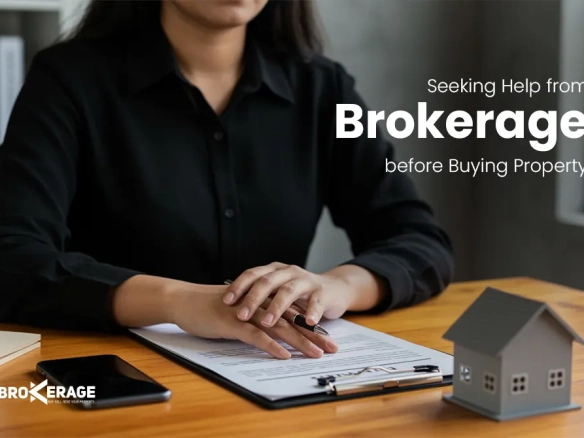Buying or selling a property can be one of the most significant financial decisions in your life. Whether it’s your first home, an investment apartment, or a commercial property, the process can often feel overwhelming. This is where a Real Estate Broker steps in, acting as the bridge between buyers and sellers, simplifying complex legal and financial steps, and ensuring smooth and secure transactions.
To truly appreciate the value they bring, let’s take a step-by-step breakdown of what a real estate broker does throughout the property transaction journey.
Step 1: Understanding Client Needs
Every successful property transaction starts with understanding the client. A real estate broker’s first job is to listen.
They conduct detailed consultations to learn what their clients want — whether they are buying, selling, or investing.
For buyers, the broker identifies:
- Preferred location
- Budget range
- Type of property (residential, commercial, or investment)
- Desired amenities or features
For sellers, the broker evaluates:
- The property’s market position
- Expected price range
- Selling timeline
- Marketing goals
This foundational step allows the broker to tailor their strategy and deliver results that align perfectly with the client’s needs.
Step 2: Conducting Market Research and Analysis
Once the client’s requirements are clear, the broker moves into market research mode.
They analyze the current real estate trends, property prices, neighborhood developments, and comparable listings.
For buyers, this means identifying the best deals in the market, properties that are priced fairly and have growth potential. For sellers, it means determining a competitive yet realistic asking price to attract serious buyers while maximizing profit. This research-driven approach ensures that both parties make informed decisions, backed by data rather than guesswork.
Step 3: Listing and Marketing Properties
If the client is selling, the broker takes charge of marketing the property. This involves creating a professional listing that highlights the property’s best features through:
- High-quality photographs and videos
- Virtual tours
- Descriptive write-ups
- Online promotions through property websites and social media
- Offline visibility through signage and local networking
A skilled broker knows how to present a property in its best light — not just selling a home, but selling a lifestyle. Their marketing expertise ensures that the property reaches the right audience, driving more inquiries and faster sales.
Step 4: Property Search and Shortlisting
For buyers, brokers utilize their access to vast property databases and extensive networks to find suitable options. They shortlist properties based on the buyer’s requirements, saving time and effort. In many cases, brokers have exclusive listings not available on public platforms — giving their clients a distinct advantage.
They also schedule visits, accompany buyers during property tours, and point out both the strengths and possible concerns about each property. This transparency builds trust and helps clients make confident choices.
Step 5: Negotiation and Offer Management
Negotiation is one of the most critical and often the most challenging parts of a real estate transaction. A professional real estate broker acts as a skilled negotiator, balancing the interests of both buyers and sellers.
For sellers, brokers strive to secure the best possible selling price. For buyers, they aim to get the most value for their budget. They handle offer letters, counteroffers, and all communications between the two parties, ensuring that emotions don’t derail the deal. This negotiation expertise often makes the difference between a successful transaction and a missed opportunity.
Step 6: Legal Documentation and Paperwork
Real estate deals involve a maze of legal documents and financial formalities. A broker assists in preparing, reviewing, and managing:
- Sale or purchase agreements
- Title deeds and property ownership documents
- Bank loan paperwork
- Registration and transfer processes
- Tax clearances and utility checks
Their familiarity with real estate laws and procedures helps prevent costly mistakes. They also coordinate with lawyers, financial institutions, and government offices to make sure all documentation is accurate and compliant.
Step 7: Coordinating with Stakeholders
A real estate transaction doesn’t happen in isolation. A broker coordinates with multiple stakeholders, such as:
- Buyers and sellers
- Lawyers and notaries
- Bank officials for mortgage approvals
- Property inspectors and valuers
- Developers and property managers
This coordination ensures that everyone is aligned, from the initial offer to the final handover. It also minimizes delays and confusion, allowing the deal to progress smoothly and efficiently.
Step 8: Finalizing the Deal
When both parties agree on the terms, the broker ensures that the transaction is executed flawlessly. They oversee the signing of the sales agreement, ensure payment milestones are met, and guide the parties through registration and possession.
Their role continues until the property is officially transferred and the client is fully satisfied. In many cases, brokers also help with post-sale assistance, such as utility name transfers or move-in coordination.
Step 9: Providing Market Insights and Advice
Beyond just buying or selling, a real estate broker serves as a trusted advisor. They share insights on:
- Market trends and price movements
- Investment opportunities
- Neighborhood developments
- Future resale potential
For investors, brokers help identify high-growth areas or properties with strong rental yields. For homeowners, they offer advice on property maintenance or renovation to enhance value. This consultative approach makes them long-term partners rather than one-time intermediaries.
Step 10: Building Relationships and Referrals
The best real estate brokers know that relationships drive the industry. They stay in touch with past clients, offering continued support, property updates, and advice. Satisfied clients often become repeat customers or refer new ones, a key reason why reputation and trust are everything in this business.
Why Real Estate Brokers Matter
While online platforms and property apps are popular today, they can’t replace the human expertise, market insight, and negotiation skill a broker brings. A professional real estate broker ensures that every step, from pricing and marketing to negotiation and documentation, is handled with precision and integrity. In short, brokers protect your interests, save your time, and maximize your return on investment.
Whether you’re buying your first home or selling a valuable property, partnering with a real estate broker can make the entire process smoother, faster, and more secure. Their expertise turns complex transactions into confident decisions, giving you peace of mind every step of the way.
Understanding this step-by-step breakdown of what a real estate broker does reveals one thing clearly: their role goes far beyond connecting buyers and sellers. They are strategists, negotiators, researchers, and advisors guiding you through one of life’s most important journeys with professionalism and care.







